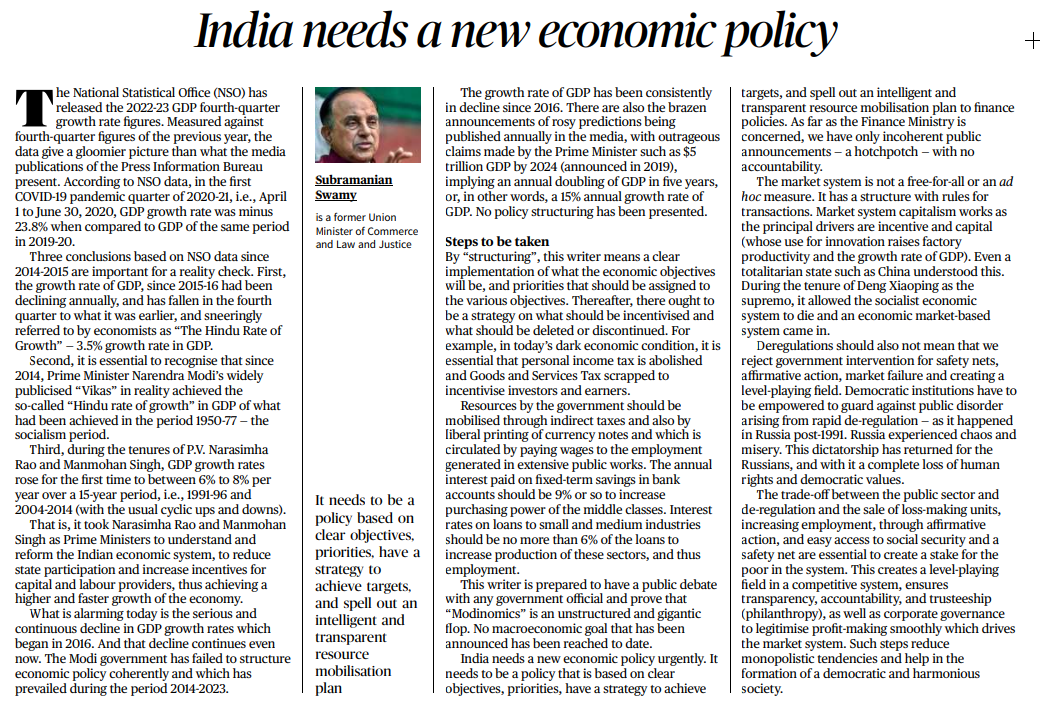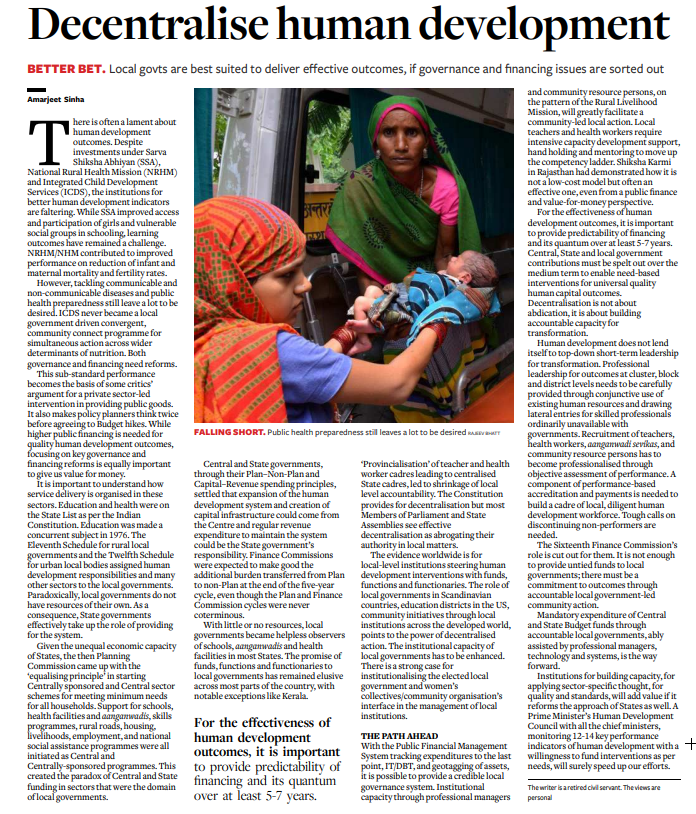INDIA IN A NEED OF NEW ECONOMIC POLICY
Introduction:
- The National Statistical Office (NSO) recently released fourth-quarter GDP growth rate figures for 2022-23.
- However, these figures paint a grimmer picture compared to the portrayal in media publications from the Press Information Bureau.
- Examining the data since 2014-2015 reveals important trends that require a reality check.
Declining GDP Growth Rate and “Hindu Rate of Growth”:
- Since 2015-16, the annual GDP growth rate has been consistently declining, reaching a level of 3.5% in the fourth quarter – reminiscent of the historically criticized “Hindu Rate of Growth.”
- This indicates a worrisome trend of slowing economic expansion.
Discrepancy in “Vikas” Narrative:
- Despite Prime Minister Narendra Modi’s emphasis on “Vikas” (development), the NSO data shows that the growth achieved during his tenure mirrors the sluggish growth rates observed during the socialism period of 1950-77.
- The promised transformative growth has not materialized.
Narasimha Rao and Manmohan Singh’s Reform Period:
- The tenure of P.V. Narasimha Rao and Manmohan Singh (1991-2004) saw a significant rise in GDP growth rates, indicating successful economic reforms that reduced state intervention and incentivized capital and labor providers.
- This contrasts with the declining growth rates seen in recent years.
Alarming Continuous Decline Since 2016:
- The most concerning aspect is the consistent decline in GDP growth rates that began in 2016 and continues to persist.
- This decline raises questions about the effectiveness of economic policies implemented during the Modi government’s tenure from 2014-2023.
Lack of Coherent Economic Policy:
- Critics argue that the Modi government has failed to establish a coherent economic policy framework.
- Despite ambitious announcements, such as the $5 trillion GDP target by 2024, no clear policy structure or steps have been presented to achieve these goals.
Call for Structured Economic Policy:
- The author emphasizes the need for a structured economic policy characterized by clear objectives, defined priorities, and a well-thought-out strategy for incentivizing key sectors.
- This structured approach would provide a roadmap for achieving growth targets.
Proposed Steps for Economic Revival:
- The author suggests specific measures to revive the economy, including the abolition of personal income tax and the scrapping of the Goods and Services Tax to incentivize investors and earners.
- Other recommendations include resource mobilization through indirect taxes and increased currency circulation, higher interest rates on savings accounts, and lower interest rates on loans to boost production and employment in key sectors.
Critique of “Modinomics” and Urgent Need for Change:
- The writer challenges the efficacy of “Modinomics,” labeling it an unstructured failure.
- The continuous decline in GDP growth rates and unmet macroeconomic goals underscore the need for a new and comprehensive economic policy.
Balancing Market System and Government Intervention:
- The article highlights the importance of striking a balance between market-driven capitalism and government intervention.
- It argues for the necessity of safety nets, affirmative action, and regulation to prevent market failures and create a level playing field.
- Democratic institutions should be empowered to ensure accountability and prevent chaos.
Conclusion:
The NSO’s data on declining GDP growth rates, combined with the lack of a coherent economic policy and ineffective macroeconomic management, raises concerns about India’s economic trajectory.
The article calls for urgent action to implement a structured economic policy that sets clear objectives, establishes priorities, and outlines strategies for growth while maintaining a balance between market dynamics and necessary government intervention.
Challenges and Prospects in Enhancing Human Development Outcomes
Introduction
- The article discusses the mixed results of various Indian government initiatives, such as Sarva Shiksha Abhiyan (SSA), National Rural Health Mission (NRHM) and Integrated Child Development Services (ICDS), aimed at improving human development indicators.
- Despite investments in these programs, the article identifies deficiencies in learning outcomes, healthcare, and nutrition.
- It also explores the possibility of private sector involvement in addressing these issues.
- The importance of governance and financing reforms, along with the need for decentralized action, is highlighted.
Challenges in Education and Health Sectors
- SSA improved access and participation, especially for girls and vulnerable groups, but learning outcomes remain a challenge.
- NRHM/NHM led to progress in reducing infant and maternal mortality, but tackling diseases and health preparedness remains inadequate.
- ICDS failed to become a community-driven program for holistic nutrition action, lacking convergence and local government involvement.
Governance and Financing Reforms
- Both governance and financing structures require reform to enhance the effectiveness of initiatives.
- The paradox of central and state funding in areas assigned to local governments has created a disconnect.
- The equalizing principle and centrally-sponsored schemes aimed to meet minimum needs, but this led to complexities in funding allocation.
Decentralization and Local Governance
- Local governments were assigned human development responsibilities, but lack financial autonomy.
- State governments took on the role of providing resources due to the unequal economic capacity of states.
- Local governments lacked resources to manage schools, health facilities, and other services effectively.
Global Evidence and Institutional Capacity
- Global evidence points to local-level institutions being effective in steering human development interventions.
- Scandinavian countries, the US education districts, and community initiatives highlight the power of decentralized action.
- Enhancing institutional capacity of local governments and involving women’s collectives/community organizations is crucial.
The Path Forward
- The use of technology, geotagging, and Public Financial Management System can improve local governance accountability.
- Professional managers and community resource persons, as in the Rural Livelihood Mission, can facilitate community-led action.
- Capacity development for local teachers and health workers is essential for improved outcomes.
Predictable Financing and Medium-Term Planning
- Long-term financing predictability over 5-7 years is crucial for effective interventions.
- Clear delineation of contributions from central, state, and local governments is needed for universal quality human capital outcomes.
Decentralization and Professional Leadership
- Decentralization involves building accountable capacity for transformation rather than abdication.
- Professional leadership at cluster, block, and district levels is necessary for effective human development outcomes.
- Objective assessment and performance-based accreditation of teachers, health workers, and community resource persons can enhance the quality of the workforce.
Sixteenth Finance Commission’s Role
- The Finance Commission should go beyond providing untied funds to local governments and emphasize outcomes.
- Mandating expenditure through accountable local governments, supported by technology and professional managers, is essential.
Prime Minister’s Human Development Council
- A council comprising chief ministers and the Prime Minister can monitor key performance indicators and allocate funds based on needs.
- Such a council can accelerate efforts towards improved human development outcomes.
Conclusion
This highlights the challenges and potential solutions for enhancing human development outcomes in India. It underscores the need for governance and financing reforms, local empowerment, professional leadership, and a collaborative approach involving various levels of government.
The path forward lies in aligning funding with outcomes, strengthening local governance, and promoting holistic, accountable actions to drive positive transformation in human development indicators.
- In what ways has the lack of convergence and community involvement hindered the effectiveness of the Integrated Child Development Services (ICDS) program in addressing wider determinants of nutrition?
Source: The Business Line



